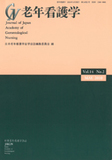Japanese
English
- 販売していません
- Abstract 文献概要
- 参考文献 Reference
本研究の目的は,地域在住高齢者を対象に,自宅内の転倒予防・安全対策教育としてHome hazard modification program(以下:HHMP)を実施した効果を評価することである.HHMPは,自宅内の危険箇所と安全策等を理解する講義,転倒事故予防教育用住宅模型教材(実用新案3148203号)を用いた演習等の30分のプログラムで,これを転倒骨折予防実践講座(週2時間×4回)内で実施した.研究対象者73名(平均年齢76.7(SD 6.2)歳)を無作為に介入群(38名),コントロール群(35名)に割り付け,分析対象者介入群27名(71.1%),コントロール群29名(82.9%)のベースライン,講座終了時,12週後の3時点の知識,転倒発生状況等を縦断的に分析した.その結果,知識量には両群で交互作用(p=.047),および単純主効果(p=.033)が認められ,多重比較では介入群のほうが講座終了時知識量が有意に高かった(Bonferroni's multiple comparison test p=.027).介入群の低転倒リスク群は講座終了時(Fisher's exact test p=.020),12週後(Fisher's exact test p=.047)の自宅内安全知識の正答者割合が有意に高かった.さらに12週の累積転倒者数は介入群に有意に少なかった(Log rank test p=.025).以上から,HHMPは高齢者への自宅内の安全知識の向上と短期維持,および短期転倒予防効果がある可能性が示唆された.
The purpose of this study was to evaluate the effectiveness of a home hazard modification program (HHMP) for preventing elders' falls in their own residence. HHMP was a 30-minute educational program to create a safer living environment by decreasing residents' fall risks and hazards. The HHMP consisted of short lectures, risks and hazards home assessment and improving safety. Educational materials consisted of a mock-up of a Japanese-style house (Japanese registered utility model ID3148203), and specific tools designed to increase home safety. The HHMP was part of a fall prevention practice held two hours each week for four weeks with a follow-up class at three months and a final class one year later.
Consenting to participate was a convenience sample of 73 elders (mean age 76.7 SD 6.2) from the community randomly assigned to the intervention (n=38) or control group (n=35). Completing the 12-week HHMP were 27 (71.1%) in the intervention group and 29 (82.9%) in the control group. Data, such as a 10-item hazard knowledge test and Flemming Fall Risk Assessment were analyzed using repeated measures ANOVA at three times: (a) baseline, (b) end of the class, and (c) after twelve weeks. Probability of falling was analyzed using survivor analysis: Kaplan-Meier analysis and log-rank test.
As a result, the intervention group's knowledge of home hazard and safety showed a significant interaction effect (p=.047) and a simple main effect (p=.033) between baseline and end of the class (Bonferroni's multiple comparison test p=.027). Only low-risk elders in the intervention group showed significantly higher correct responses on the preventing falls on the three-point scale item, between baseline and end of the class (Fisher's exact test p=.020), and after twelve weeks (Fisher's exact test pp=.047). Moreover the number of falls was significantly lower in the intervention group compared to the control group (log-rank test p=.025). Our HHMP has the possibility for short-term fall prevention and improved knowledge of hazards for elders living in the community.
Copyright © 2010, Japan Academy of Gerontological Nursing All rights reserved.


